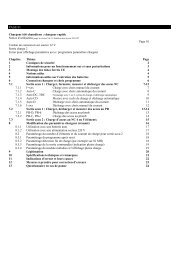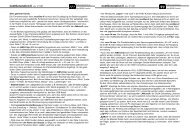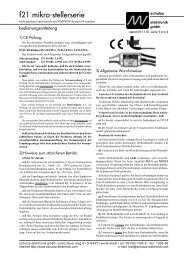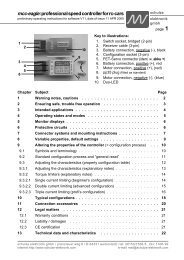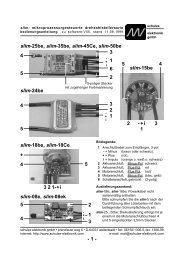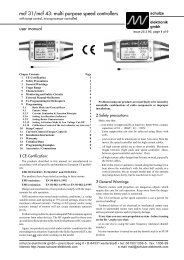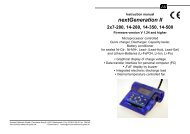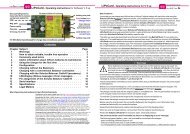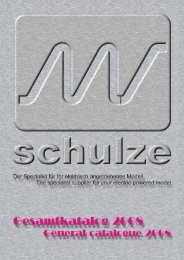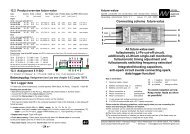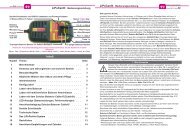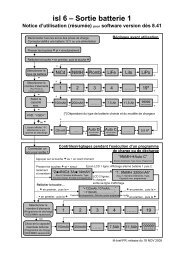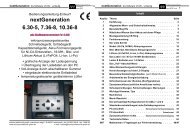ecolader: rapid discharger/charger series - Schulze Elektronik GmbH
ecolader: rapid discharger/charger series - Schulze Elektronik GmbH
ecolader: rapid discharger/charger series - Schulze Elektronik GmbH
You also want an ePaper? Increase the reach of your titles
YUMPU automatically turns print PDFs into web optimized ePapers that Google loves.
<strong>ecolader</strong>: <strong>rapid</strong> <strong>dis<strong>charger</strong></strong>/<strong>charger</strong> <strong>series</strong><br />
Operating instructions for software V1.04, date of issue 05 MAY 1998<br />
2 How to obtain reliable, trouble-free operation<br />
Be sure to protect the <strong>charger</strong> from direct sunshine,<br />
dust, damp and rain. If the unit<br />
should get wet, let it dry out thoroughly and<br />
have it checked and cleaned before re-use.<br />
The case openings must never be obstructed or<br />
sealed.<br />
The <strong>charger</strong> produces considerable heat when<br />
working - up to 100°C at the heat-sink; don't<br />
burn yourself! - and it is important to provide<br />
an effective means of dissipating the heat.<br />
This applies in particular after a high-rate<br />
charge of a pack of few cells, or a high-current<br />
discharge process, when the unit<br />
should be allowed plenty of time to cool<br />
down before re-use.<br />
Check the <strong>charger</strong> regularly - cables, connectors,<br />
case and screen - for possible damage<br />
and intermittent contacts.<br />
Keep the charge leads (between <strong>charger</strong> and<br />
pack) as short as possible. CE directives require<br />
cables no longer than 20 cm. The cables<br />
attached to the battery must also be as<br />
short as possible, and the conductor crosssection<br />
should be no less than 2.5 mm2 -<br />
even for a receiver battery!<br />
Use high-quality connectors exclusively (goldcontact<br />
types) at both ends of the charge<br />
cable, and run each cable through one of<br />
the ferrite tubes (CE tube) supplied with the<br />
<strong>charger</strong>. These tubes are essential in order<br />
to meet CE requirements (see Section 3).<br />
Twist cables together to avoid interference.<br />
Always keep to the battery manufacturer's recommended<br />
charge currents and times. You<br />
should only charge packs which are expressly<br />
stated to be suitable for <strong>rapid</strong>-charging.<br />
In theory the unit can be powered by a stabilised<br />
mains power supply, but we cannot<br />
recommend this generally.<br />
If you insist on using the <strong>charger</strong> in this way,<br />
you must check carefully to ensure that your<br />
combination of <strong>charger</strong> / power supply<br />
works correctly under all circumstances.<br />
schulze<br />
elektronik<br />
gmbh<br />
Page 3<br />
Many transmitters feature a reverse-flow diode<br />
which must be by-passed if you wish to <strong>rapid</strong>-charge<br />
the battery. Be sure to read the<br />
RC system instructions before you try this.<br />
Make it a habit to check that the charge quantity<br />
indicated is roughly what you expected<br />
after the unit has switched off automatically.<br />
This is the easy and reliable way to notice<br />
when and if the unit detects a "battery full"<br />
state erroneously. Premature charge termination<br />
is most likely with deep-discharged<br />
packs, and/or packs of few cells (carry out a<br />
test charge first!), although particular cell<br />
types tend to cause problems.<br />
Caution: if you fail to notice that a battery is<br />
not fully charged, using that pack in a model<br />
aircraft could easily cause a crash!<br />
The sequence of letters "a", "b"... indicates the<br />
probability of a full charge, but the "full"<br />
message does not necessarily follow them.<br />
The letters sequence often appears at the<br />
start of the charge, especially if deep-discharged<br />
cells are in use.<br />
Cells to be recharged together must be connected<br />
by soldering if the fully automatic<br />
programs are to function correctly. Don't use<br />
battery boxes with spring contacts!<br />
The <strong>ecolader</strong> only sets the charge current calculated<br />
as optimum for the battery if that<br />
current does not exceed any of the permissible<br />
parameters for the <strong>charger</strong>.<br />
Results with Ni-MH batteries are good provided<br />
that you set the charge current manually,<br />
and keep to charge currents of 1 C or less.<br />
The unit needs about 10 minutes time to detect<br />
the correct number of cells of a deeply discharged<br />
pack.<br />
If the voltage at battery socket 3 is < 0.5 V the<br />
<strong>charger</strong> assumes reversed polarity.<br />
schulze elektronik gmbh • prenzlauer weg 6 • D-64331 weiterstadt • tel: 06150/1306-5, fax: 1306-99<br />
internet: http://www.schulze-elektronik.com e-mail: mail@schulze-elektronik.com



